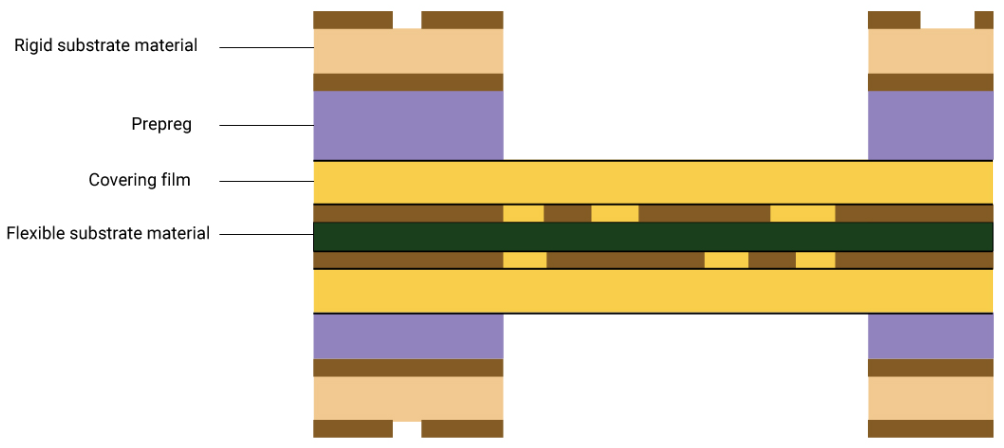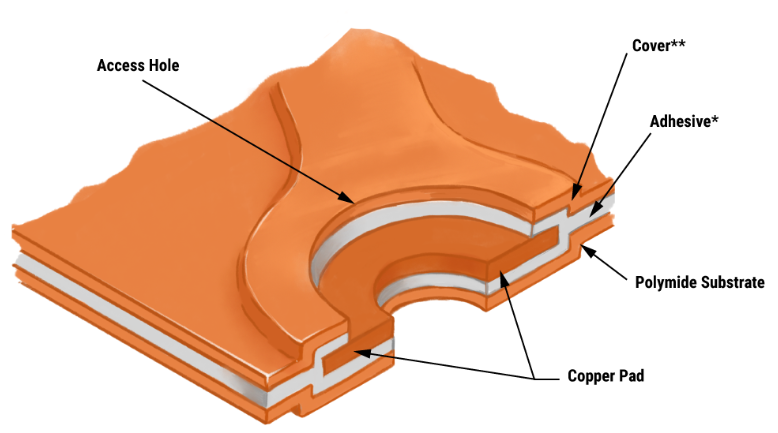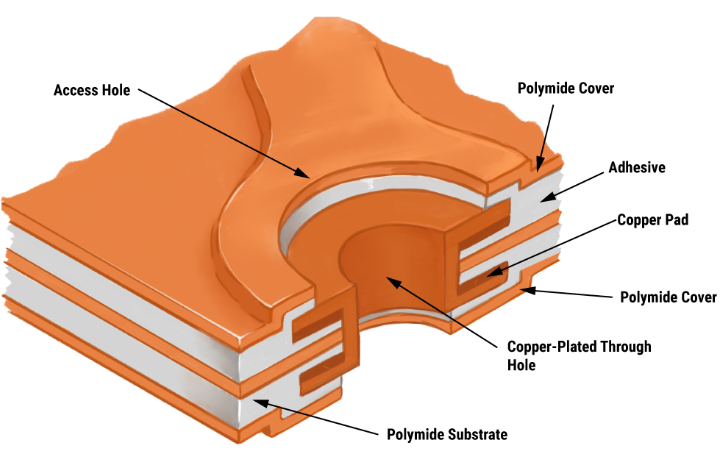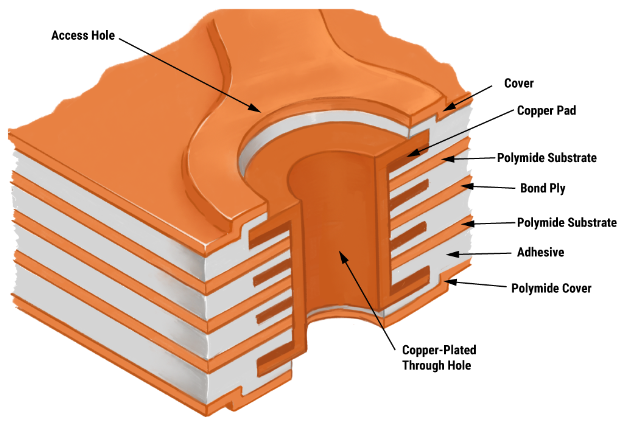What are Flexible Printed Circuit Boards
A flexible printed circuit board features a combination of several printed circuits as well as components that are positioned on a flexible substrate. These circuit boards are also known as flex circuit boards, flex PCBs, flex circuits, or flexible printed circuits. These printed circuit boards are designed using the same components as rigid printed circuit boards. However, the only difference is the board is made such that it flexes to a desired shape during the application.
Flex PCBs are flexible circuits made of very thin substrates with high levels of bendability. A rigid-flex board is a combination of rigid and flexible technologies. Scroll down to learn more about this topic as we answer some of the most common questions.
Flexible PCBs are made of very thin substrates with high levels of bendability, tensile strength, and physical flexibility. They can also be molded into complex three-dimensional shapes for use across a diverse range of applications. These boards were originally used within the military industry due to their durability, reliability, and lightweight. Now, they can be found in nearly every industry such as medical devices, fitness wearables, and cameras. Flex boards also eliminate traditional wiring harnesses and ribbon connectors.
What is the difference between FFC and FPC?
FFC (flexible flat cables) refers to any type of electrical cable which is flexible and flat whereas an FPC is a flexible printed circuit. FFC is a type of ribbon cable and is named after its wide and flat structure. They are usually straight connectors without any additional components. FFC cables usually consist of a plastic film, to which multiple metallic connectors are bonded and the spacing between each connector is referred to as the ‘pitch’.
Types of Flex Circuit Boards
Flexible printed circuit boards can be designed in a wide range of configurations and specifications. However, they are classified on the basis of layers as well as configurations.
Flexible Circuit Boards Classification Based on Configurations
Flexible circuit boards are categorized into these types on the basis of their configuration
- Rigid-Flex PCBs: A rigid-flexible board is a combination of rigid and flexible technologies. Here, one or more flex circuits are used to connect sub-circuits in rigid PCBs. The flexible section of the rigid-flex are generally multilayered.
Plated through holes are used to secure the interconnectivity among these layers. These boards use a combination of rigid and flex PCB materials. The materials include core, prepreg, copper foil, flexible laminates, coverlay, and bond plies. The below figure shows the basic structure of a rigid-flex circuit board.
- HDI Flexible PCBs: HDI is an abbreviation for high density interconnect. These PCBs are perfect for applications that demand higher performance than regular flexible PCBs. HDI flex circuit boards are designed incorporating several features such as micro-vias and they offer better layout, construction, as well as designs. HDI flexible PCBs utilize much thinner substrates than regular flexible PCBs, which helps reduce their package sizes as well as improves their electrical performance.
Flexible Circuit Boards Classification Based on Layers
Flex circuits are classified into single-sided, double-sided, and multi-layered boards
The flex circuit boards are categorized into the following types on the basis of their layers.
- Single-Sided Flexible Circuit Boards: Single-sided are the most basic type of flexible printed circuit boards. These boards consist of a single conducting layer on a flex substrate. A flexible polyimide is laminated to a thin sheet of copper. Holes may be drilled through the substrate to allow lead of the components to pass during the soldering process. A polyimide coverlay can be used for insulation and environmental protection of the circuit.

- Double-Sided Flexible Circuit Boards: Double-sided flexible printed circuit boards have two conductive layers (one on each side of the flex substrate). Here, the copper foil is laminated on either side of the polyimide substrate. Plated through holes or vias establish electrical connection between the layers. These boards can be fabricated with a protective layer on one side, both sides, or neither side, depending on the circuit design requirements.

- Multi-Layered Flexible Circuits: Multi-layered flex circuits consist of more than two copper conductors. Like double-sided boards the conductive layers are interconnected through PTHs or vias. These circuits are the best solution to tackle the design challenges such as: specific impedance requirements, unpreventable crossovers, crosstalk, high component density, and shielding.
What are the materials used in flexible PCBs?
PCB materials used in flex sections are just a few microns thick but can be reliably etched. This often makes them preferable over rigid boards. Flex circuits are built using unreinforced substrates made up of polyimide dielectric film cladded with rolled copper. The rolled copper is more flexible than the copper foil used in the rigid PCBs. Bondply is used to isolate the conducting layers similar to prepreg found in rigid boards. It is a layer of polyimide film with adhesive coated on either side. This layer also insulates the outer surfaces of the flex stackup.
Flex materials offer better dielectric constant compared to standard rigid materials. They offer uniform thickness as they are made of acrylic base. The rigid materials, on the other hand, are built from interwoven glass fiber and the thickness of these materials may not be uniform. Below are few flex materials that we generally use:
- DuPont Pyralux AP
- DuPont Pyralux LF
- DuPont Pyralux FR
Materials Used for Making Flexible Printed Circuit Boards
Copper is the most common conductor material used for making flexible PCBs. Their thickness may range from .0007ʺ to 0.0028ʺ. At Hemeixin, we can also create boards with conductors such as aluminum, Electrodeposited (ED) copper, Rolled Annealed (RA) copper, Constantan, Inconel, silver ink, and more.
Insulators and Material Finishes Used for Flex Circuit Boards
Being one of the most experienced flex circuit board manufacturers, we are the first choice when clients conceptualize their complex flex circuit board designs. We can create circuit boards in different flexible substrate materials including polyimide, polyester, Polyethylene Naphthalate (PEN), Polyethylene Terephthalate (PET), and more. In addition to these, we can also provide these boards in any preferred material finishes including leaded or lead-free soldering, tin, immersion nickel/gold, hard nickel/gold, wire bondable gold, silver, carbon, and many more. The choice of the material finish will entirely depend on customers’ application requirements. For instance, tin finishing is perfect for covering exposed pads on the flex circuits, whereas soft gold covering will be ideal for covering when assembly process such as wire bonding is being performed.
Benefits of Flexible Printed Circuit Boards
Over the years, flexible printed circuit boards have gained immense popularity owing to the benefits they offer. Here are a few benefits listed:
- Lightweight and Package Size Reduction: Flexible circuit boards can fit into applications where no other solutions may work. The circuit boards are thin, lightweight, and can be easily creased, folded, as well as positioned in the areas, where other components cannot fit in. At Hemeixin, our engineers often utilize the benefits of 3D packaging geometry to ensure further package size reduction.
- Accurate Designs: Flexible printed circuit boards are often designed and assembled using automated machinery. This helps reduce the errors that were involved in hand-built wires and harnesses, and ensures accuracy, which is a key requirement for advanced electronic devices.
- Freedom of Design: The design of flexible circuit boards is not limited to just two layers. This offers lots of design freedom to designers. The flexible PCBs can be easily made as single sided with a single access, single sided with double access, and multilayered – combining several layers of rigid and flexible circuits. This flexibility makes it a perfect choice for complex configurations with several interconnections. The flexible circuit boards can be designed to accommodate both – plated through-hole and surface mounted components.
- High Density Configurations Possible: The flexible printed circuit boards can feature a mix of both -plated through-hole and surface mounted components. This combination helps accommodate high density devices with minute narrow separation in between. Thus, denser and lighter conductors can be designed, and space can be freed for additional components.
- Flexibility: Flexible circuits can connect with multiple planes during the execution. This helps reduce the weight and space issues faced by rigid circuit boards. Flexible circuit boards can be easily flexed to different levels during the installation without the fear of failure.
- High Heat Dissipation: Owing to the compact designs and denser device populations, shorter thermal paths are created. This helps dissipate the heat faster than a rigid circuit. Also, flexible circuits dissipate heat from both sides.
- Improved Air Flow: Streamlined design of flexible circuits enable better thermal dissipation and improves the air flow. This helps keep the circuits cooler than their rigid printed circuit board counterparts. The improved airflow also contributes to the long term performance of electronic circuit boards.
- Durability and Long-term Performance: A flex circuit board is designed to flex up to 500 million times an average lifespan of an electronic device. Many of the PCBs can be bended up to 360 degrees. Low ductility and mass of these circuit boards help them withstand the impact of vibrations and shocks, thereby improving their performance in such applications.
- High System Reliability: Interconnections were one of the main concerns in the earlier circuit boards. Interconnection failure was one of the main reasons for circuit board failure. Nowadays, it is possible to design PCBs with lesser interconnection points. This has helped improve their reliability in challenging conditions. In addition to this, the utilization of polyimide material helps improve the thermal stability of these circuit boards.
- Streamlined Designs Made Possible: Flexible circuit board technologies have helped improve circuit geometries. The components can be easily surface mounted onto the boards, thus simplifying the overall design.
- Suited for High Temperature Applications: Materials such as polyimide can easily withstand high temperatures, as well as offer resistance against materials such as acids, oils, and gases. Thus, the flexible circuit boards can be exposed to temperatures up to 400 degrees Centigrade, and can withstand harsh working environments.
- Supports Different Components and Connectors: Flex circuits can support a wide range of connectors and components, including crimped contacts, ZIF connectors, direct soldering, and more.
- Cost Savings: Flexible and thin polyimide films can be easily fit into a smaller area, so they help reduce the overall assembly costs. Flexible circuit boards also help reduce testing time, wire routing errors, rejects, and reworking time.
Applications of Flex Circuit Boards
The flexible printed circuit boards can be used for dynamic flexing, as well as static applications. For static applications, the circuit board is designed for minimum flexing. The circuit is only flexed during the installation. Dynamic flexible circuit boards are designed for regular flexing. Some common applications of these circuit boards include printers, flip-type cell phones, robots, and so on.
Flexible circuit boards are widely used in applications that demand high accuracy and regular flexing. Some popular examples include:
- Avionics
- Airbag systems
- Antilock brakes
- Bar code equipment
- Battery packs
- Cameras
- Fuel pumps
- Motion systems
- Satellites
- Semiconductor test and manufacturing devices
- Ultrasound probes and medical devices
At Hemeixin, our advanced facility and vast experience enable us to assure the fastest turnaround times on flex circuit board prototypes. Our flex circuit board prototyping service is handled by industry experts who have helped clients conceptualize, design, and manufacture complex designs effectively.







